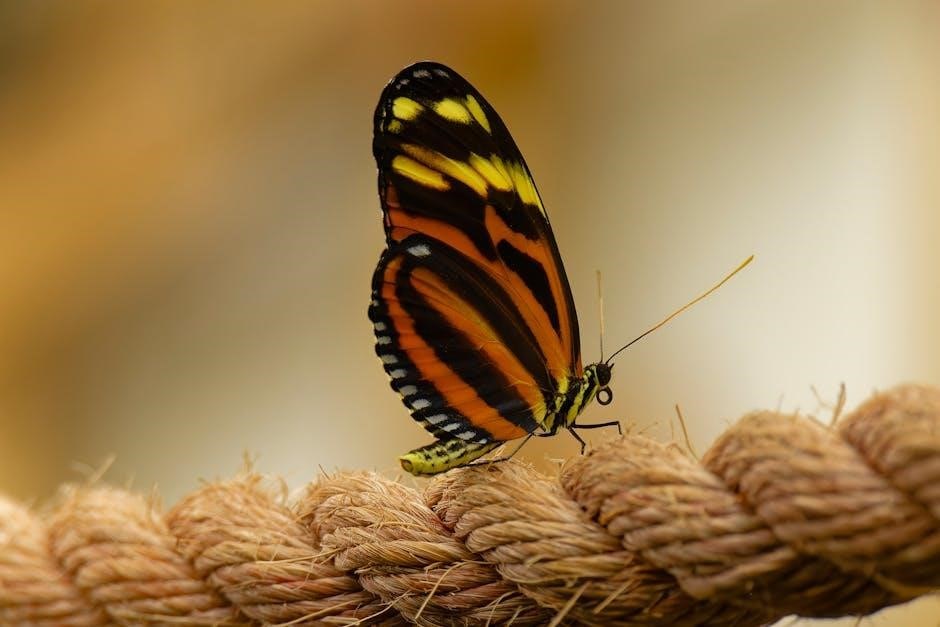Welcome to the enchanting world of butterfly raising! This guide provides a comprehensive path to nurturing these delicate creatures, ensuring a successful transformation from caterpillar to winged beauty.
1.1 Welcome to the Butterfly-Raising Experience
Welcome to an unforgettable journey of nurturing and wonder! With our butterfly-raising kit, you’ll embark on a magical adventure, guiding caterpillars through their transformation into beautiful butterflies. This comprehensive guide offers step-by-step instructions, expert tips, and fascinating insights, ensuring a successful and educational experience for both kids and adults. Let’s dive into this incredible journey together!
1.2 Purpose of the Guide
This guide is designed to provide clear, step-by-step instructions for raising butterflies, ensuring a successful and educational experience. It covers everything from setting up the habitat to caring for caterpillars and releasing adult butterflies. With troubleshooting tips and expert advice, this guide helps you navigate the entire process confidently, fostering a deeper connection with nature and its wonders.

Overview of the Butterfly Life Cycle
The butterfly life cycle includes four stages: egg, caterpillar, chrysalis, and adult. This transformation, called metamorphosis, typically takes 3-4 weeks, offering a fascinating educational experience.
2.1 Stages of Butterfly Development
The butterfly life cycle consists of four distinct stages: egg, caterpillar, chrysalis, and adult. Eggs hatch into caterpillars, which eat and grow before forming a chrysalis. Inside, metamorphosis occurs, transforming the caterpillar into a butterfly. Adults emerge, their wings expanding before flying. This process typically takes 3-4 weeks, offering a captivating view of nature’s transformation process for observers of all ages.
2.2 Understanding the Metamorphosis Process
Metamorphosis is a biological transformation where caterpillars reorganize their structures to become butterflies. Inside the chrysalis, tissues break down and re-form into wings, organs, and adult features. This complex process, lasting about 2-4 weeks, is essential for their survival. Observing this magical change offers insights into nature’s remarkable adaptability and the intricate life cycle of these fascinating creatures.
Materials and Supplies Needed
Your butterfly kit includes a mesh habitat, caterpillar food, and a water spray bottle. Additional items like sugar-water feeders and a mister help maintain a clean, humid environment.
3.1 Components of a Butterfly Kit
A typical butterfly kit includes a reusable mesh habitat, caterpillar food, a water spray bottle, and a voucher or certificate for larvae. Some kits also provide a sugar-water feeder, instructions, and a care guide. Additional items like misters or droppers may be included to maintain humidity and feed butterflies. These components ensure a complete setup for raising and observing butterflies effectively.
3.2 Additional Items Required for Care
Besides the kit, you may need a clean, shallow dish for water, a mister or spray bottle for humidity, and a sugar-water feeder for adult butterflies. A dropper for feeding and a soft brush for handling caterpillars can also be useful. Ensure a mild dish soap is available for cleaning, and maintain a warm, sheltered location for the habitat, ideally between 65-75°F for optimal growth.
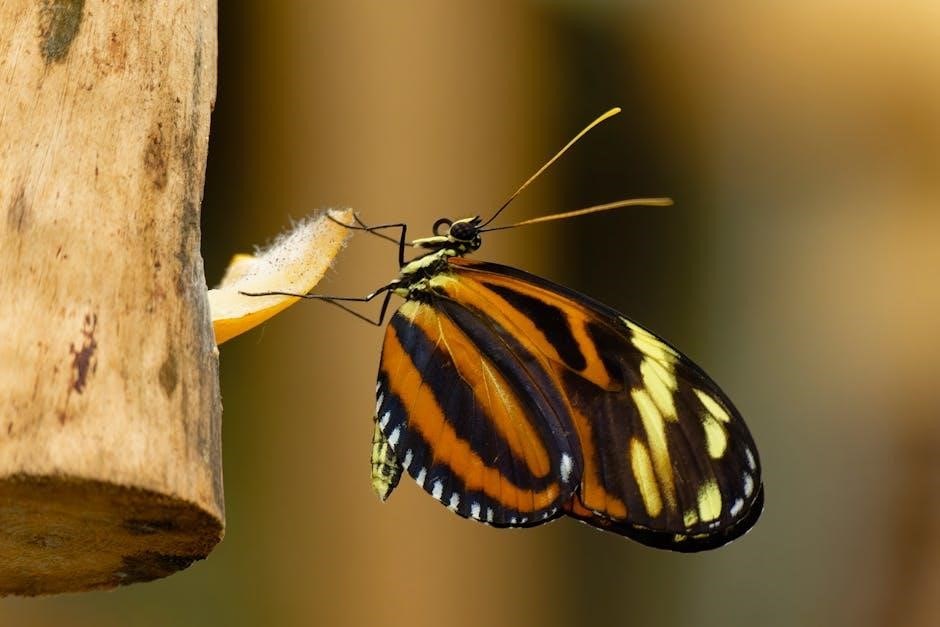
Setting Up the Butterfly Habitat
Assemble the mesh habitat according to the kit instructions, ensuring it is secure and well-ventilated. Place it in a quiet, sheltered location away from direct sunlight and drafts for optimal conditions.
4.1 Assembling the Mesh Habitat
Begin by carefully unfolding and securing the mesh habitat’s frame to ensure stability. Attach the mesh panels tightly to allow proper ventilation. Ensure all zippers and openings are secure to prevent escape. Place the habitat on a sturdy, flat surface in a quiet area, away from direct sunlight and drafts. Regularly clean and maintain the habitat to promote healthy development of your butterflies.
4.2 Placing the Habitat in an Ideal Location
Place the habitat in a warm, sunny spot, avoiding direct sunlight to prevent overheating. Ensure it is away from drafts and predators. Position it on a stable surface, such as a table or shelf, near a window for natural light. Maintain a consistent temperature between 65-75°F for optimal growth. Avoid placing it in humid or extreme environments for the best results.
Caring for the Caterpillars
Place the caterpillar cup in a quiet, upright position to ensure proper growth. Monitor them as they eat and grow for 7-10 days before forming chrysalises.
5.1 Feeding the Caterpillars
Feed caterpillars the provided food in their cup; no additional food is needed. Keep the cup upright to prevent contamination. Clean the cup gently if necessary, ensuring caterpillars remain undisturbed. They will eat continuously for 7-10 days before entering the chrysalis stage. Avoid over-handling to promote healthy growth and transformation.
5.2 Monitoring Caterpillar Growth
Place the caterpillar cup in a quiet, undisturbed area. Observe the caterpillars daily, noting their size and appetite. They will eat continuously for 7-10 days before forming a chrysalis. Ensure the cup remains upright to prevent contamination and promote healthy growth. Avoid handling the caterpillars excessively to minimize stress and support their natural development process.
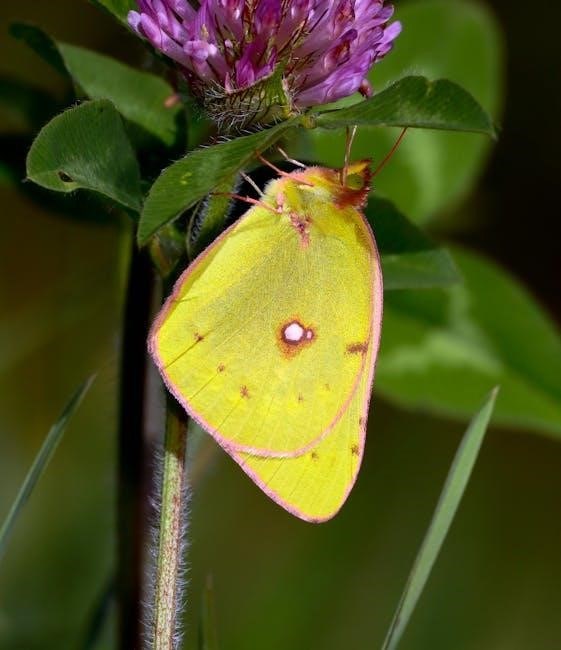
The Chrysalis Stage
This stage is crucial as the caterpillar transforms into a butterfly. Keep the habitat stable and avoid disturbing the chrysalis. The process usually takes 7-14 days, after which the butterfly will emerge and pump fluid into its wings to expand them fully.
6.1 Observing the Chrysalis Formation
Place the chrysalis in a secure, upright position within the habitat. Observe the transformation quietly, as disturbances can harm the process. The chrysalis stage typically lasts 7-14 days, during which the caterpillar undergoes metamorphosis. Avoid touching or handling the chrysalis, as this can damage the delicate formation. Keep the habitat stable and maintain proper humidity to support the transformation process. Gently mist the habitat with water daily to ensure optimal conditions. This critical phase requires patience, as the butterfly develops its wings and prepares for emergence.
6.2 Caring for the Chrysalis
Keep the chrysalis in a stable, upright position within the habitat to prevent damage. Mist the habitat lightly with water daily to maintain humidity. Avoid moving or disturbing the chrysalis, as this can disrupt the transformation. Ensure the habitat remains clean and free from contaminants. Monitor for condensation, which can indicate proper humidity levels. Be patient, as the butterfly will emerge when fully developed.
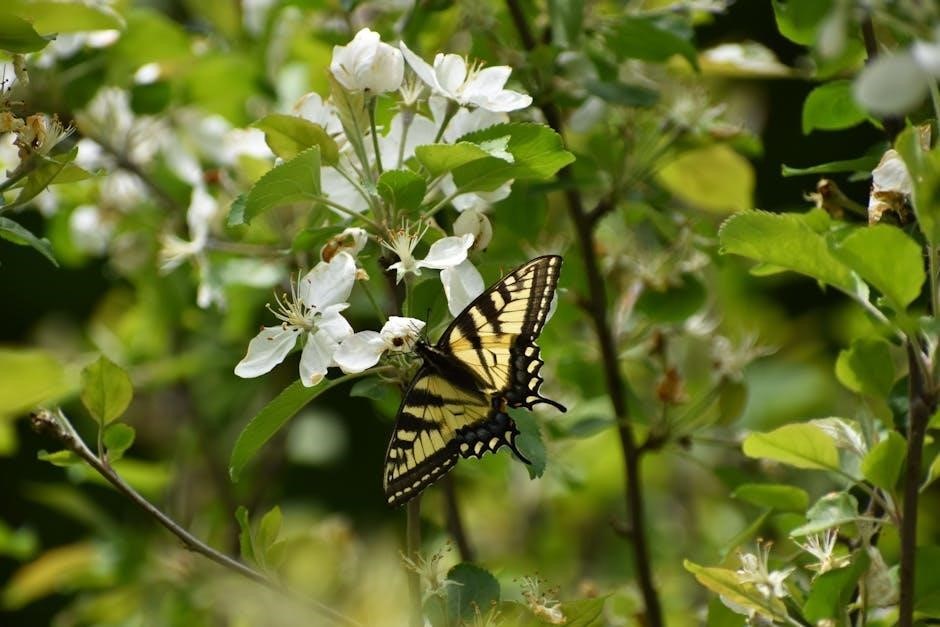
Feeding and Maintaining the Butterflies
Provide butterflies with a sugar-water solution using the feeder. Mist the habitat daily with water to maintain humidity and keep their environment clean and thriving.
7.1 Providing Food for the Butterflies
To feed your butterflies, prepare a sugar-water solution by mixing one sugar packet with 1 cup of water. Fill the feeder cup almost to the top and place it in the habitat. Mist the outside of the enclosure daily with room-temperature water to keep butterflies hydrated. This simple care ensures they thrive and enjoy their environment.
7.2 Keeping the Habitat Clean
Regular cleaning is essential for a healthy butterfly environment. Gently remove waste and uneaten food daily. Mist the habitat with water to maintain humidity and cleanliness. After releasing the butterflies, wash the habitat with warm water and mild dish soap. Allow it to dry completely before reusing it for future butterfly-raising experiences.
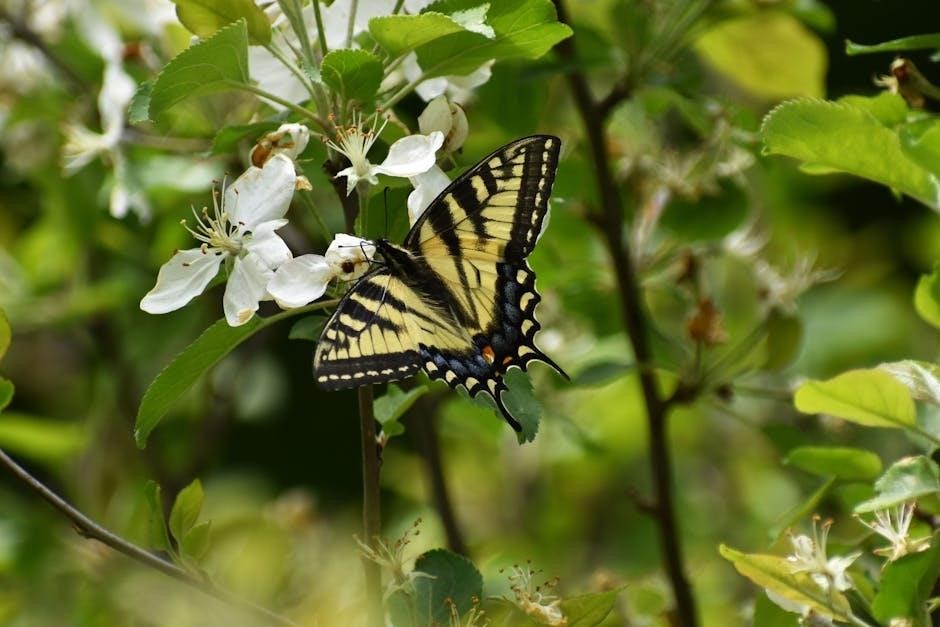
Releasing the Butterflies
Release butterflies in warm, sunny weather, avoiding windy or cold conditions; Open the habitat slowly to allow them to fly out naturally and freely.
8.1 Choosing the Right Time and Place
Release butterflies in warm, sunny weather, avoiding cold or windy conditions. Choose a safe, open area with flowers for nectar. Release in the morning to allow butterflies to adapt and find food. Avoid areas with predators or pesticides. Ensure the location is ideal for their natural habitat and survival, providing a gentle transition to their new environment.
8.2 Preparing for Release
Before releasing, ensure butterflies are fully emerged and dry. Feed them with a sugar solution or fresh fruit to energize them. Mist the habitat lightly to maintain humidity. Avoid releasing at night or in harsh weather. Gently place the butterflies near flowers to encourage natural behavior. Keep the habitat clean and secure during preparation to minimize stress and ensure a successful release.

Cleaning and Reusing the Habitat
After releasing the butterflies, gently wash the habitat with mild soap and warm water. Rinse thoroughly and allow it to dry completely to prevent mold growth. Store the cleaned habitat in a dry, secure location for future use, ensuring all accessories are properly organized and ready for the next cycle.
9.1 Washing the Habitat
Wash the habitat with mild dish soap and warm water using a soft brush to gently scrub away any residue. Rinse thoroughly to remove all soap residue, then pat dry with a clean towel. Allow the habitat to air dry completely to prevent mold growth. This ensures the habitat remains clean and safe for future use with new caterpillars or butterflies.
9.2 Storing the Habitat for Future Use
Clean and dry the habitat thoroughly before storage. Place it in a cool, dry location away from direct sunlight to prevent damage. Ensure all parts are secure and free from pests. Store in its original packaging if possible. Proper storage ensures the habitat remains in good condition for future butterfly-raising experiences. Regular checks are recommended for maintenance.
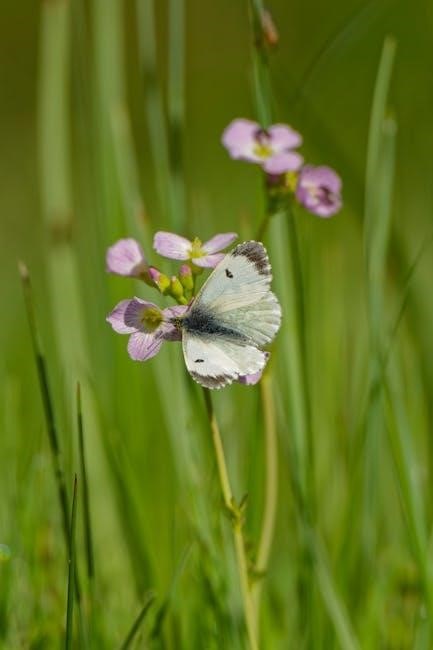
Troubleshooting Common Issues
Identify common issues early, such as diseased caterpillars or habitat problems. Regular cleaning and monitoring can prevent many challenges. Always consult the guide for solutions.
10.1 Dealing with Diseased Caterpillars
If caterpillars show signs of disease, such as discoloration or lethargy, isolate them immediately to prevent spreading illness. Clean the habitat thoroughly with mild soap and water. Ensure proper ventilation and avoid overcrowding to maintain healthy conditions. Refer to the care guide for detailed steps on managing diseased caterpillars and promoting overall health.
10.2 Addressing Habitat Maintenance Problems
Regularly clean the habitat to prevent mold and bacteria growth. Ensure proper ventilation to maintain humidity levels. Check for pests and isolate affected areas. Replace food and water sources as needed. If issues persist, consult the care guide for troubleshooting tips to create a healthy environment for your caterpillars and butterflies.
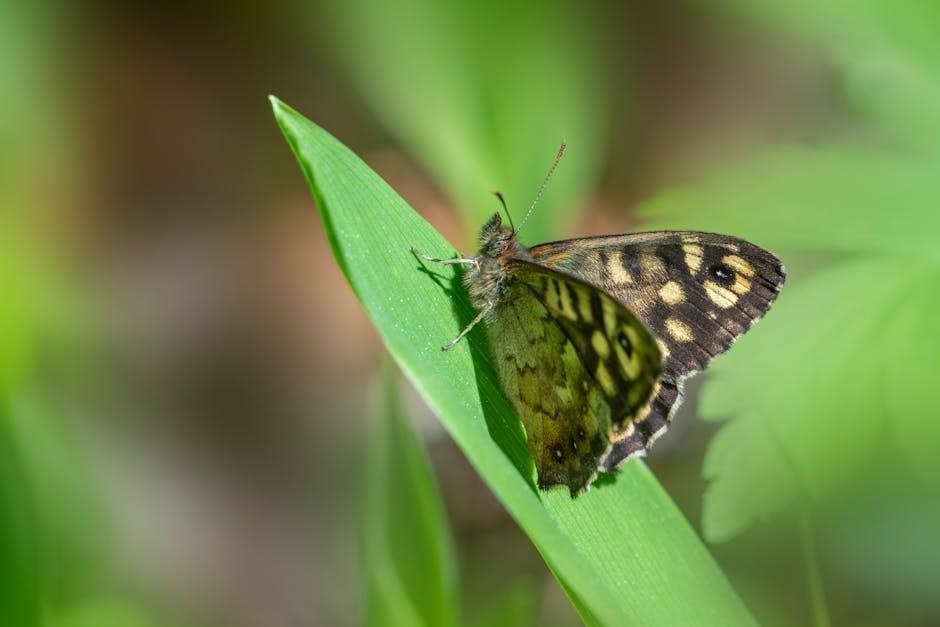
Frequently Asked Questions
Explore common questions about butterfly care, life cycles, and habitat maintenance. Find answers to troubleshooting and tips for a successful butterfly-raising experience in our detailed guide.
11.1 General Care Questions
What are the best practices for feeding butterflies? How often should I mist the habitat? Can caterpillars be handled safely? These questions and more are answered here to ensure optimal care for your butterflies and caterpillars, addressing feeding, environment, and hands-on interaction to promote healthy growth and development throughout their life cycle.
11.2 Questions About the Butterfly Life Cycle
How long does each stage of a butterfly’s life cycle last? What triggers the transformation from caterpillar to chrysalis? Why do butterflies emerge differently? These questions explore the magical process of metamorphosis, providing insights into the duration, signs, and natural wonders of each developmental phase, from egg to winged adult.

Additional Resources and Support
Explore our video tutorials for step-by-step guidance. For further assistance, contact our customer support team or visit our resource page for detailed information.
12.1 Accessing Video Tutorials
Our video tutorials provide step-by-step guidance for raising butterflies. Visit our official website or YouTube channel to access these resources. For additional support, explore our Pinterest boards, which offer instructional guides, fun activities, and expert tips to enhance your butterfly-raising experience. Should you need further assistance, contact our customer support team for personalized help.
12.2 Contacting Customer Support
For any questions or concerns, our customer support team is here to help. Visit our official website to find contact details, including email and phone options. We also offer live chat support during business hours. Our team is dedicated to ensuring your butterfly-raising experience is enjoyable and successful. Please don’t hesitate to reach out for assistance or additional resources.
